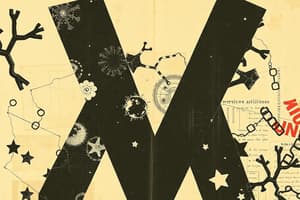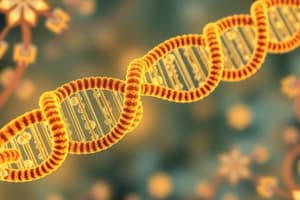Podcast
Questions and Answers
How would you communicate your design plans with the construction crew that would work on the house?
How would you communicate your design plans with the construction crew that would work on the house?
By creating a blueprint.
What do cells use their 'design plans' for proteins?
What do cells use their 'design plans' for proteins?
DNA
Is the displayed segment a part of a DNA or RNA molecule? How do you know?
Is the displayed segment a part of a DNA or RNA molecule? How do you know?
DNA because it has the base A-T and G-C.
What happens when RNA polymerase acts on DNA?
What happens when RNA polymerase acts on DNA?
In molecules of RNA, uracil takes the place of the DNA base ___
In molecules of RNA, uracil takes the place of the DNA base ___
What is the nucleotide sequence of the mRNA strand you built?
What is the nucleotide sequence of the mRNA strand you built?
How would a change to the nucleotide sequence in a DNA segment affect the mRNA transcribed from the DNA?
How would a change to the nucleotide sequence in a DNA segment affect the mRNA transcribed from the DNA?
Which anticodon do you think would attach to the mRNA's start codon?
Which anticodon do you think would attach to the mRNA's start codon?
What happens when you place the next two tRNA molecules on the mRNA strand?
What happens when you place the next two tRNA molecules on the mRNA strand?
What happens when release factors bind to stop codons?
What happens when release factors bind to stop codons?
Why are stop and start codon signals necessary for protein synthesis?
Why are stop and start codon signals necessary for protein synthesis?
Describe the process of transcription.
Describe the process of transcription.
Describe the process of translation.
Describe the process of translation.
How do genes determine the traits of an organism?
How do genes determine the traits of an organism?
How might transcription or translation errors be offset?
How might transcription or translation errors be offset?
The translation between mRNA and amino acids is the same for all living things.
The translation between mRNA and amino acids is the same for all living things.
Flashcards are hidden until you start studying
Study Notes
RNA and Protein Synthesis
- Blueprint Analogy: Designing a house requires communication through a blueprint, similar to how cells utilize blueprints, or DNA, to construct proteins.
- DNA's Role: Cells depend on DNA as their source for the design plans of protein synthesis, including instructions necessary for building large molecules.
- Base Composition: DNA comprises adenine (A), cytosine (C), guanine (G), and thymine (T). In contrast, RNA contains adenine, cytosine, guanine, and uracil (U). The presence of thymine indicates a DNA segment.
- RNA Polymerase Function: This enzyme facilitates the transcription process by splitting DNA strands, allowing for mRNA synthesis.
- Thymine Replacement: In RNA, uracil takes the place of thymine found in DNA, altering the nucleic acid structure.
- mRNA Nucleotide Sequence: mRNA strands are constructed through the process of transcription, which involves sequencing that runs through seven strands.
- Impact of Nucleotide Changes: Alterations in DNA nucleotide sequences lead to changes in both the template strand and its complementary strand, directly affecting mRNA transcription.
- Anticodon Interaction: The anticodon ACC would attach to the start codon of mRNA, initiating the translation process.
- tRNA and Protein Production: Placement of tRNA molecules on the mRNA strand is essential for the assembly of amino acids, ultimately resulting in protein creation.
- Stop Codons: Stop codons, such as UAG, UAA, and UGA, signal the termination of protein synthesis. Release factors bind to these codons, resulting in the detachment of synthesized proteins.
- Significance of Codons: Start codons initiate protein synthesis, while stop codons signify completion, ensuring accurate translation.
- Transcription Process: Transcription involves the formation of a complementary mRNA strand from a DNA template, crucial for gene expression.
- Translation Process: In translation, ribosomes read mRNA codons while tRNA brings anticodons and corresponding amino acids, linking them to form proteins.
- Genetic Determinants of Traits: An organism's traits are dictated by inherited genes, reflecting the genetic material passed from parents.
- Error Offset in Transcription/Translation: Multiple codons can code for a single amino acid, providing a buffer against potential transcription or translation errors.
- Theory of Evolution and Genetics: The universal mechanism of translating mRNA to amino acids supports the theory of evolution, indicating a common genetic heritage among all living organisms.
Studying That Suits You
Use AI to generate personalized quizzes and flashcards to suit your learning preferences.



